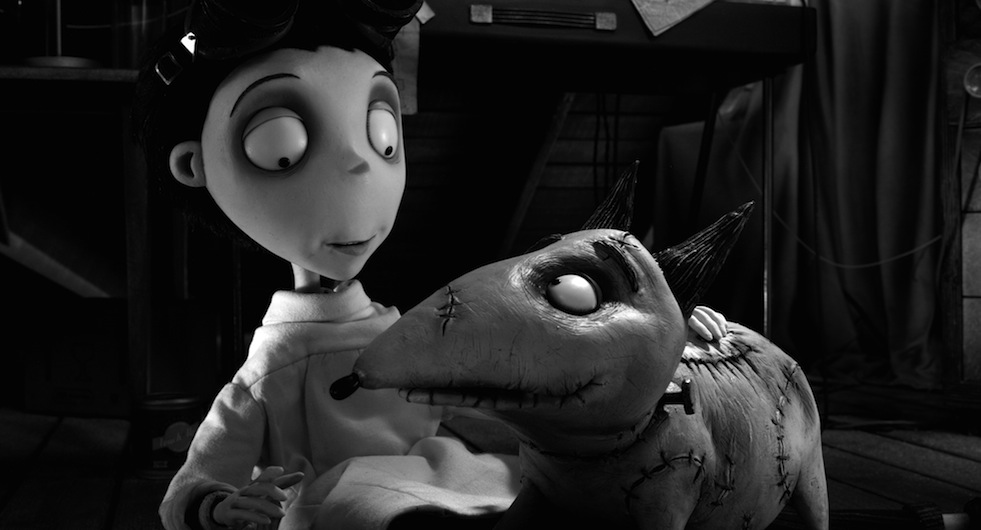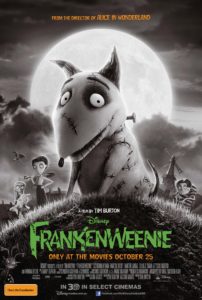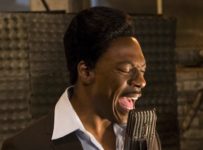Tim Burton’s triumphant return to Disney animation is a beautiful love-letter to monster mash-ups.
[stextbox id=”grey” caption=”Frankenweenie (2012)” float=”true” align=”right” width=”200″]
Director: Tim Burton
Writer: John August
Runtime: 87 minutes
Starring: Charlie Tahan, Frank Welker, Winona Ryder, Catherine O’Hara, Martin Short, Martin Landau, Robert Capron, Atticus Shaffer
Distributor: Disney
Country: US
Rating (?): Highly Recommended (★★★★)
Although Frankenweenie is listed as director Tim Burton’s first official animated film for Disney, his history with the House of Mouse goes back to the earliest days of his career. Working as an animator, storyboard artist and concept artist on films such as The Fox and the Hound, The Black Cauldron and Tron for Disney, his own style never really gelled with the conservative studio. They did, however, allow him to complete work on a live action short called Frankenweenie (1984), in which a young boy brings his dog back to life. Essentially being fired over this film, being deemed too dark for audiences, it is one of the best examples of how Hollywood changes over the course of several decades. His production on The Nightmare Before Christmas (1993), released under the Touchstone banner, remains one of Disney’s top merchandising franchises, and following the $1 billion global box office of Alice in Wonderland (2010), the once unseemly short is now the basis of a full-length stop-motion animated classic.
Young Victor Frankenstein (Charlie Tahan) is a bit of a loner, dedicated to science and as faithful to his dog Sparky as the pooch is to him. Worried that he isn’t more social, his parents (voiced by Catherine O’Hara and Martin Short) encourage him to play baseball. However, tragedy strikes on his first game, when Sparky chases a ball onto the road and is killed by a car. Partly inspired by the creepy science teacher Mr. Rzykruski (Martin Landau), Victor resurrects his dearly departed dog. However, when troubled kid Edgar “E” Gore (Atticus Shaffer) reveals Victor’s secret, his entire class develops a fascination with reanimation.
Unlike Tim Burton’s recent live-action films, which are very much a thinly veiled redux of what he has done before, Frankenweenie is a consciously retro choice. Time warping not only back to his own earlier film but also to an entire history of schlock cinema. Apart from the obvious influences of James Whale’s Frankenstein (1931) and Bride of Frankenstein (1935), there are also some giant love letters to Daikaijû Gamera (1965), Gremlins (1984) and The Mummy (1932). On the surface, it is a pastiche of those films, keeping in line with the current animation trend of celebrating the pop of culture at the speed of light. Yet at all times there is a sense that regular Burton collaborator John August’s script is anything less than an affectionate homage to monster pictures, but keeping the same level of character development and investment that one would expect from Pixar’s best work. What’s most impressive is that all of these elements, from the vaguely racist Toshiaki (James Hiroyuki Liao) to the childlike Peter Lorre in Edgar, all seem like they should be exactly where you find them.
Frankenweenie immediately distinguishes itself by going against the grain and rather boldly being entirely in monochromatic hues, but nevertheless having an each way bet and being in 3D as well. Stripped of colour, the artistry behind the stop-motion animation and the level of character detail becomes even more evident. Take for example the rings around Sparky’s eyes, a perfect approximation of Burton’s original sketches brought to life in a way that would make Victor proud. While the 3D is perhaps unnecessary, it adds a layer of depth that is now expected in modern animation.
Burton’s animation over the last two decades has kept alive the childlike wonder that has been absent from his live-action pieces. What remains true in this latest version of his almost three-decades old story is the heartwarming tale of a boy and his dog. Genuinely and proudly weird, it celebrates the goofy nature of its characters but imbues them all with relatable attributes. Except for Weird Girl. She’s a freak.
Frankenweenie is released in Australia on 25 October 2012 from Disney.





